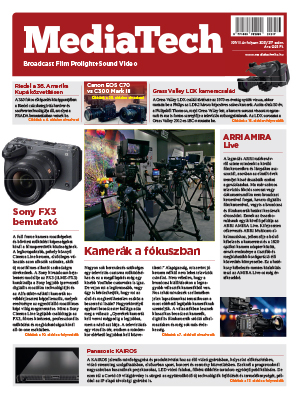
It would have been a shock if the organisers of the London 2012 Olympic Games had not included stereo 3D in their plans so it was no great surprise when the official announcement of its inclusion came.
Back in 2008, around the time of the Beijing Games, live 3D broadcasting was an experiment. In March of that year when the BBC trialled the world’s first live 3D HD transmission to select cinemas of a Calcutta Cup rugby match, the mission was considered a success that the feed reached the cinema at all.
By 2010 with the multi-camera, 25-match production of the FIFA World Cup, a technical workflow had been established and this year, at the US Open and Wimbledon, it had developed into a fully integrated outside broadcast. The technology is proven, and while there will continue to be technological developments, the focus has turned to refining production values.
However, while the IOC and its broadcasting subdivision the Olympic Broadcast Services (OBS) could be confident of delivering a technically proficient and polished 3D product for 2012 they still need to ensure that the time and effort was worthwhile.
That it intends to produce 300 hours of 3D (from a total of 5000 hours total games coverage) is perhaps the main surprise. At that volume 3D can no longer be considered an experiment or just for archive as seemed the most likely scenario even six months back. The IOC has clearly received strong messages from its major rights holders including NBC, the BBC and ESPN in support of a sizeable commitment to 3D production.
“The only reason we have decided to produce in 3D is to satisfy the demands of our rights holders,” Manolo Romero (pictured), chief executive of Olympic Broadcast Services (OBS) tells TVBEurope. “We would not be producing in 3D were it not for them.”
Although he declined to name which broadcasters have requested 3D, Romero said that there were currently 15 on board, a figure he expected to grow considerably, including some “very major ones”.
Events at 14 venues (of the 32) will be used for coverage, enough for OBS to create a 10-hour daily mix of 3D live and highlights. This will be produced separately from the main 2D broadcast by three outside broadcast crews. It will also be distributed with English commentary.
Each mobile unit will carry 12-14 rigs for around 40 camera positions. Fifteen to 20 ENG crews sporting Panasonic integrated 3D camcorders (including its new prosumer model HDC-Z10000 and the AG-3DP1) will also contribute as well as being used “to get near to the athletes in some sports,” Romero says.
“We will cover the opening and closing ceremonies, and major Olympic areas of gymnastics, track and field, swimming and the Olympic park,” he adds. “We will also experiment with other sports dependent on the demand for them from rights holders. Some of the sports have not been captured in 3D before.”
These include swimming and canoeing. The potential of canoeing with oars and boats slaloming round posts in splashing water is obvious though swimming could be trickier given that much of the athlete’s action happens underwater. Presumably OBS would have to position the 3D cameras as close to the water level as possible, or optimise the underwater tracking camera system.
“One of the challenges is to locate 3D camera positions in places where there are currently optimum seating positions,” says Romero. “We will find a way. We need to try to do our best to make it look good, but it will not be easy. We will follow our philosophy as with other technology which is to push the technology, to try our best and when we reach a limit which we cannot overcome we hope that for the next games we will do better.”
Winning the prize
Rights holders will be able to receive the live feed or ENG-ingested footage at the IBC to compile their own 3D broadcasts, but OBS will also create a live and highlights package of one hour, daily. “This is for those broadcasters who do not have a 24-hour dedicated 3D channel, but who can perhaps segment short 3D broadcasts on their existing channels,” says Romero. This would include the BBC, which aired its first live 3D coverage earlier this year on BBC HD of the Wimbledon tennis finals.
OBS will be contracting a 3D production specialist, but this has yet to be awarded and will be arguably the most prestigious and certainly largest 3D live event project to date.
There aren’t too many production teams with the appropriate expertise to choose from. Sony was the driving force behind the FIFA World Cup 2010 3D and Wimbledon in 3D, partnering with CAN Communicate and using Element Technica rigs on both occasions - though CAN would consider themselves technology-agnostic.
3ality Technica, which now owns Element Technica, has huge experience as a technology partner to Sky Sports in tandem with OB crews from Telegenic and others and can’t be dismissed.
The Cameron-Pace Group (CPG) has conducted 140 live events, mostly sports, including the recent X Games for ESPN. Its business model requires the client to sign up to CPG technology and production services. Another option would be to task the Belgian firm Alfacam, which is supplying a third of the 60+ OB facilities for London 2012, to organise specialist teams.
Since Alfacam is also majority equipped with Grass Valley gear, the recent CPG Grass Valley technology alliance lends weight to the idea that Cameron and Pace are front-runners.
Vince Pace, co-chairman of CPG, revealed to TVBEurope that he is in discussions about a 40-45 3D camera event which would be about the size of the Olympics job. Pace says: “We shot with 14 cameras on the US Open and we shot 19 cameras for the X Games. We are talking about a production today that will carry 40-45 cameras.
“The chief question is, what does it cost to do World Cup soccer or the Olympics in 3D and we are probably the leading company providing a cost model that can compete with 2D.”
Cameron adds: “It would be fantastic to do the Olympics. I don’t think there is anybody around who could do it better in terms of integrating 3D cameras into robocams and unique POV situations.”
In fact, the Olympic 3D contract is in the gift of sponsor Panasonic, which is between a rock and hard place deciding whether to grant the oxygen of Olympics publicity to two of its chief rivals whose kit will surely be heavily involved (Sony or GV).
As for Romero, he is equally, if not more, excited by the innovation of multi-channel distribution for next year which he says will help create the biggest ever audience for an Olympics yet.
“We did this for the first time for Vancouver but this is on an entirely different scale,” says Romero. “We are providing 12 channels by satellite of Olympics coverage in English, Arabic and Spanish language commentary as well as a complementary data feed which will enable any broadcaster which may not have the resources to come to London to organise a substantial Olympics operation.
“In some cases broadcasters do not have the bandwidth to be able to bring all the signals back to their domestic audience on their own. They can use it as a main source or as secondary source or simply as a source for additional shots. I believe this is going to be a revolution on its own.”
Broadcasters in New Zealand, Asia, Korea and the US, among others, will benefit, which will help boost the already massive global audience for the event. “I have no doubt this will bring the biggest Olympic Games audience ever. Hands down. That is one of our goals,” says Romero.







